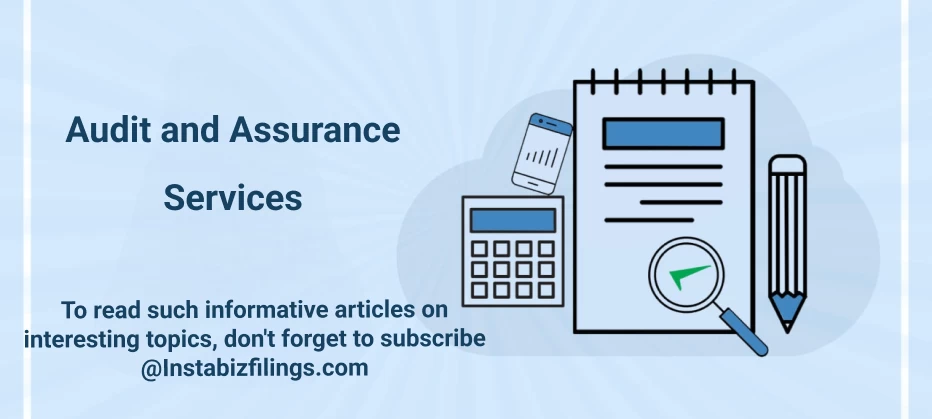
Audit and Assurance Services
May 19, 2025 by Team Instabizfilings
Introduction to Audit and Assurance Services
The broad services provided under Audit and Assurance ensure accurate presentations of financial records and non-financial disclosures in organizations. The services help to validate whether financial data follows GAAP or IFRS standards while ensuring that internal systems and operational controls operate correctly.
Key Components:
-
The main task of Audit Services involves analyzing financial statements and verifying their verification along with ensuring standards compliance.
-
Assurance Services deliver wider services that boost stakeholder confidence about organizational information despite whether it involves financial data or not.
Why Audit and Assurance Services Matter
-
Ensures Transparency : Organisational reporting systems include transparent, unbiased financial evaluations conducted by independent auditors. The confidence investors and creditors place in these audits enables regulators and other stakeholders to trust them.
-
Enhances Credibility : A company achieves higher financial statement credibility through completion of audit or assurance review procedures. An organization requires this characteristic to sustain relationships between stakeholders who involve customers and suppliers and their workforce.
-
Mitigates Risk : Through audit services organizations can find risks that exist in their financial and operational systems. Assurance services expand past evaluation by actively assessing process effectiveness as well as control measures to handle risks successfully.
-
Regulatory Compliance : Particular businesses need to perform audits that comply with industry standards and tax laws and other statutory obligations as required by regulatory bodies and governments. These regulations find their enforcement through assurance services.
-
Increases Operational Efficiency : By reviewing and enhancing internal controls, processes, and policies, audit and assurance services increase the efficiency of business operations.
Types of Audit and Assurance Services
- External Audits
-
If a company allows an independent third party to verify its financial statements then this auditing process becomes known as an external audit. The inspections occur either yearly or when an external body requires auditing.
-
The audit's essential purpose exists to establish an unbiased viewpoint regarding the company's financial statements' accuracy for representing their actual financial state.
-
Audits executed under regulatory standards adopt either GAAP or IFRS depending on which system applies to the specified geographical region or jurisdiction.
-
The final output from an audit comprises three possible opinions regarding financial statements which may include unqualified (clean) or qualified (with reservations) or adverse (not accurate).
- Internal Audits
-
External organizations or internal audit teams of an organization conduct evaluations on governance practices together with internal controls and risk systems through established firms.
-
The organization requires evaluation of internal processes to determine their effectiveness at risk management and compliance and operational goal attainment.
-
The outcome delivers suggested strategies to enhance operational efficiency as well as risk management and compliance execution methods.
- Compliance Audits
-
The focus of these audits determines whether an organization meets external regulatory requirements including tax laws as well as environmental regulations and industry-specific standards.
-
The main goal of this audit is to confirm the organization follows all applicable laws and regulations which prevents legal penalties.
-
Report outcomes should represent non-compliant areas together with recommended solutions for correction.
- Forensic Audits
-
The process of forensic auditing involves specialized examinations to track down financial misconduct and asset theft and abnormal financial behavior.
-
Organizations use this objective to probe financial crimes because it helps discover misconduct when they face suspicions of fraud or legal action.
-
The outcome from the forensic audit produced a detailed report which could help both legal proceedings and internal investigations.
- Integrated Audits
-
A merger between financial audits with operational audits constitutes an integrated audit. The assessment combines financial accuracy evaluation with operational control effectiveness checks.
-
The primary target of this assessment centers on combining financial reporting with operational assessment particularly aimed at major business operations and companies listed for public trade.
-
The evaluation produces an all-inclusive document that evaluates financial accuracy and operational effectiveness.
- Agreed-Upon Procedures
-
The auditor alongside the client determines particular audit procedures which form the basis of this agreement. Audits have defined limits which are determined by client specifications even though complete financial statement audits are not mandatory.
-
The objective of limited audit procedures consists of performing particular checks or procedures which the client specifically requests such as validating assets and liabilities.
-
The results of particular auditing operations will be reported in a document.
- Assurance Services
-
Beyond audit services firms provide expanded services which validate various forms of information including environmental and governance compliance frameworks.
-
The main goal is to build stakeholder trust that information displays accurate data and dependable reliability together with complete content.
-
The outcome of such assessments produces a review report that establishes trust with stakeholders about information accuracy.
Audit Process: Step-by-Step Guide
A professional assessment of financial statements along with operational controls uses defined procedures to validate their reliability and accuracy.
-
Planning and Risk Assessment
- The audit process requires auditors to assess audit scope along with studying possible risks.
- Auditors begin their work through meetings with managers and stakeholders who explain operational functions together with organizational goals to the auditors.
-
Internal Control Evaluation
- Audits include examinations of control systems which govern internal processes in addition to risk management evaluation for assessing operational validity.
- Auditors need to speak with relevant staff members while observing business operations and testing the organization's systems.
-
Fieldwork and Testing
- Auditors conduct data collection and financial record testing while assessing the entire internal control framework at this phase.
- Internal audit professionals conduct tests on transactions as they review legal compliance and validate financial records and their accuracy.
-
Analysis and Reporting
- Auditors make their analysis of testing results before presenting an official report that contains their findings.
- The auditors evaluate financial statements and operational processes through reporting any detected inconsistencies with their opinion about both statements and operations.
-
Final Opinion
- An audit terminates with the auditor issuing their report that contains their professional opinion (unqualified or qualified or adverse).
- The report includes suggested improvements together with necessary corrective measures whenever required.
Benefits of Audit and Assurance Services
-
Enhanced Financial Accuracy : Audits confirm that financial statements contain no unacceptable mistakes or missing data so stakeholders can view a clear financial status of the organization.
-
Improved Risk Management : Audits of internal controls and operational systems allow staff members to discover potential weaknesses and risks in advance of causing substantial financial or operational damage.
-
Regulatory Compliance : Businesses receive assurance services that help them follow relevant rules which minimizes the potential for penalties together with legal problems.
-
Investor Confidence : Business entities that maintain regular audit and assurance review processes receive higher trustworthiness ratings which brings investors and creditors along with business partners.
-
Operational Improvements : Businesses achieve better operational practices through both internal audits and assurance services which reveal operational inefficiencies that can be used for improvement.
Challenges in Audit and Assurance Services
-
Cost of Services : Small businesses find it difficult to accept the cost of comprehensive audits because they are highly expensive.
-
Regulatory Complexity : Business organizations encounter difficulties complying with regulatory requirements because standards often change through modifications to tax regulations along with industry standards.
-
Time and Resource Constraints : Audit processes require substantial time and resources to complete and they become more demanding when organizations have extensive complex operations.
-
Auditor Independence : Auditors must step away from any situation that challenges their ability to be independent and objective. Audits fail to maintain their integrity when conflicts of interest come into play.
-
Data Privacy and Security : The management of sensitive financial and operational data creates data privacy and security problems for auditors to address. Auditors need to establish proper security measures that protect sensitive data and information.
Conclusion
Audits and assurance services protect sustainable financial and operational integrity by providing necessary oversight. The services construct transparent solutions which meet compliance requirements and improve risk management systems to build stakeholder trust. Business enterprises throughout different industrial sectors gain essential benefits from assurance services that include both independent audits and internal control assessments as well as extended assurance-based services.
Disclaimer
The information provided in this blog is purely for general informational purposes only. While every effort has been made to ensure the accuracy, reliability and completeness of the content presented, we make no representations or warranties of any kind, express or implied, for the same.
We expressly disclaim any and all liability for any loss, damage or injury arising from or in connection with the use of or reliance on this information. This includes, but is not limited to, any direct, indirect, incidental, consequential or punitive damage.
Further, we reserve the right to make changes to the content at any time without prior notice. For specific advice tailored to your situation, we request you to get in touch with us.


